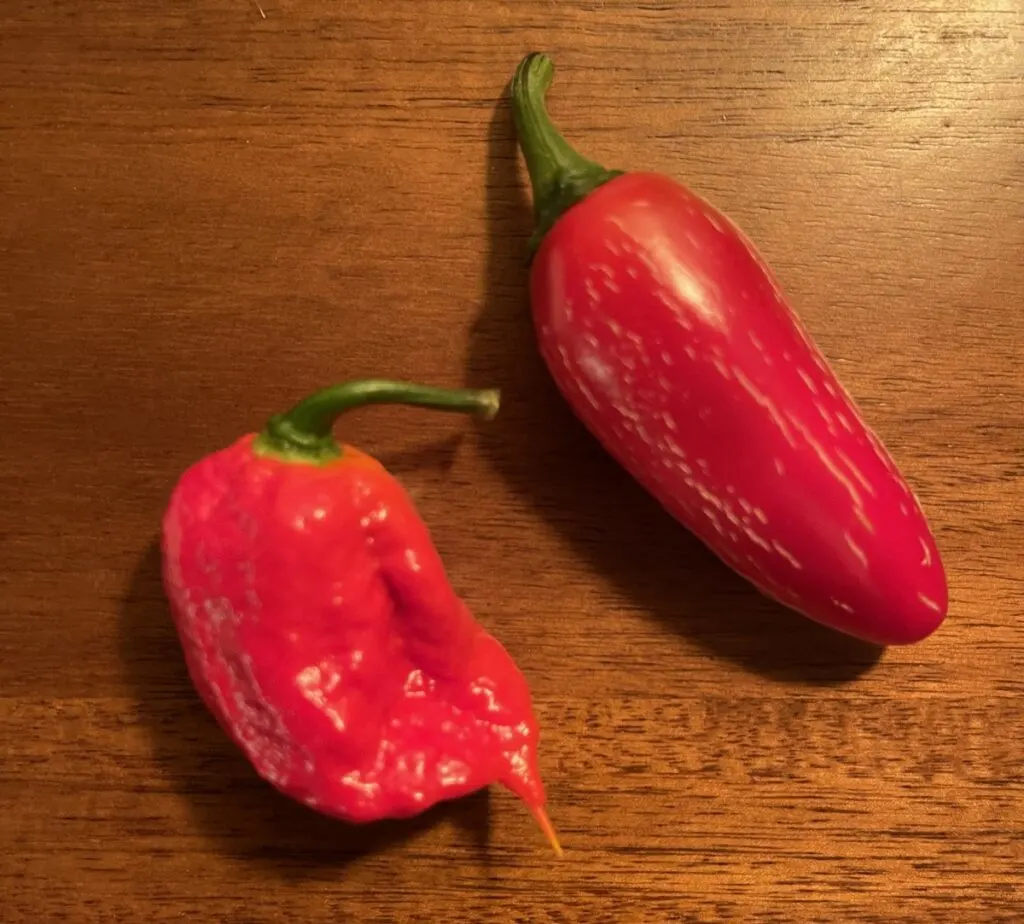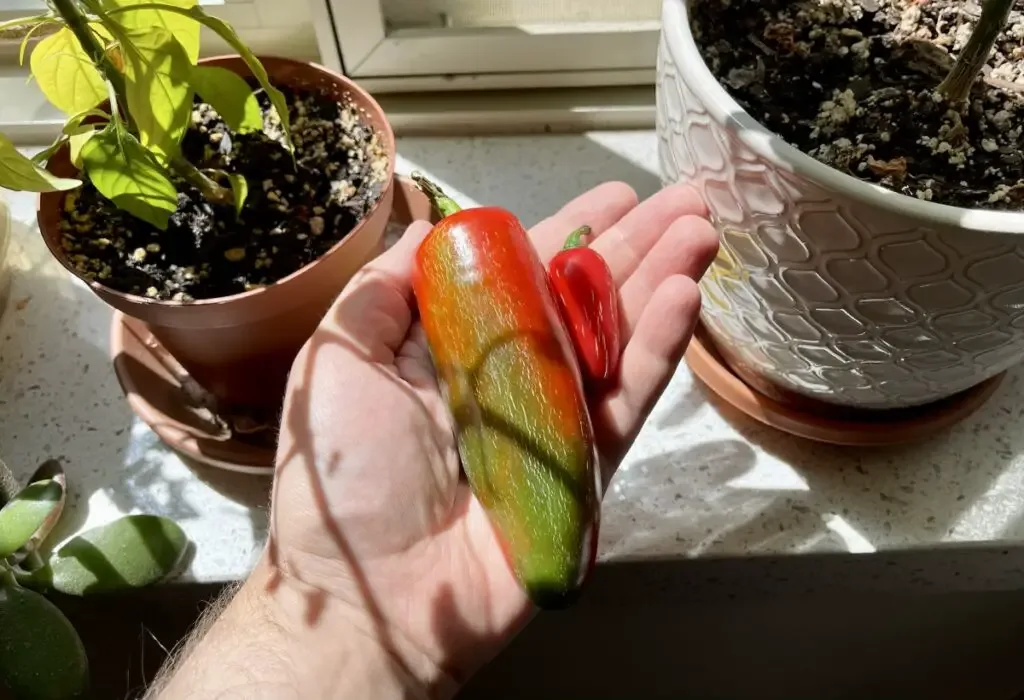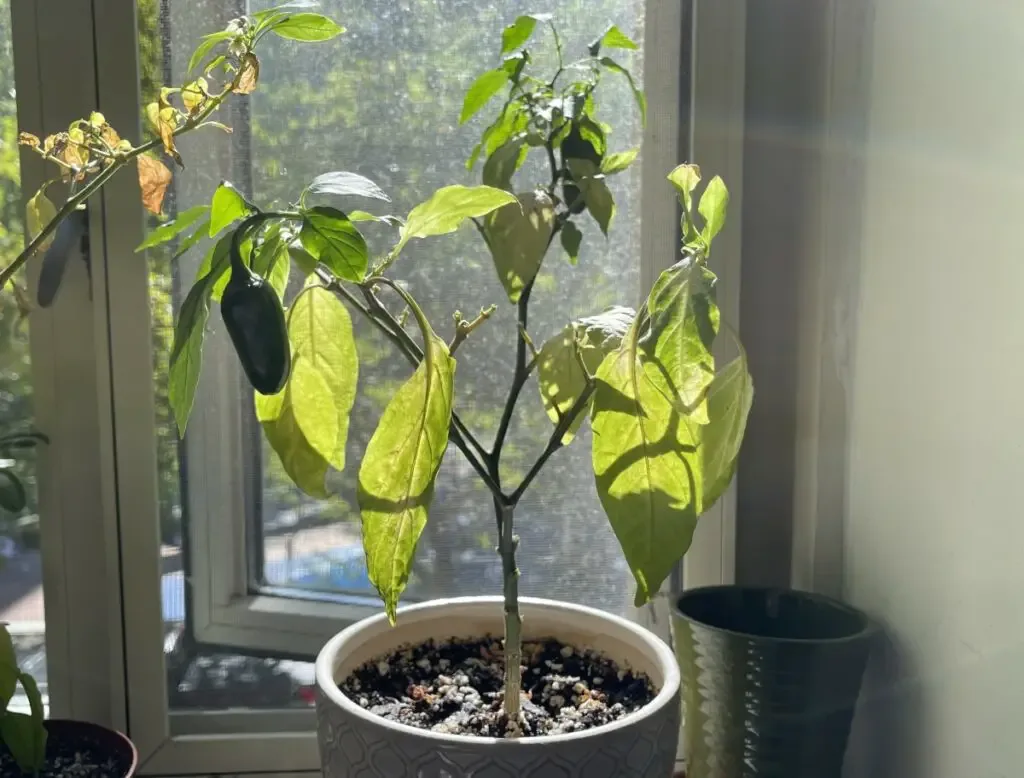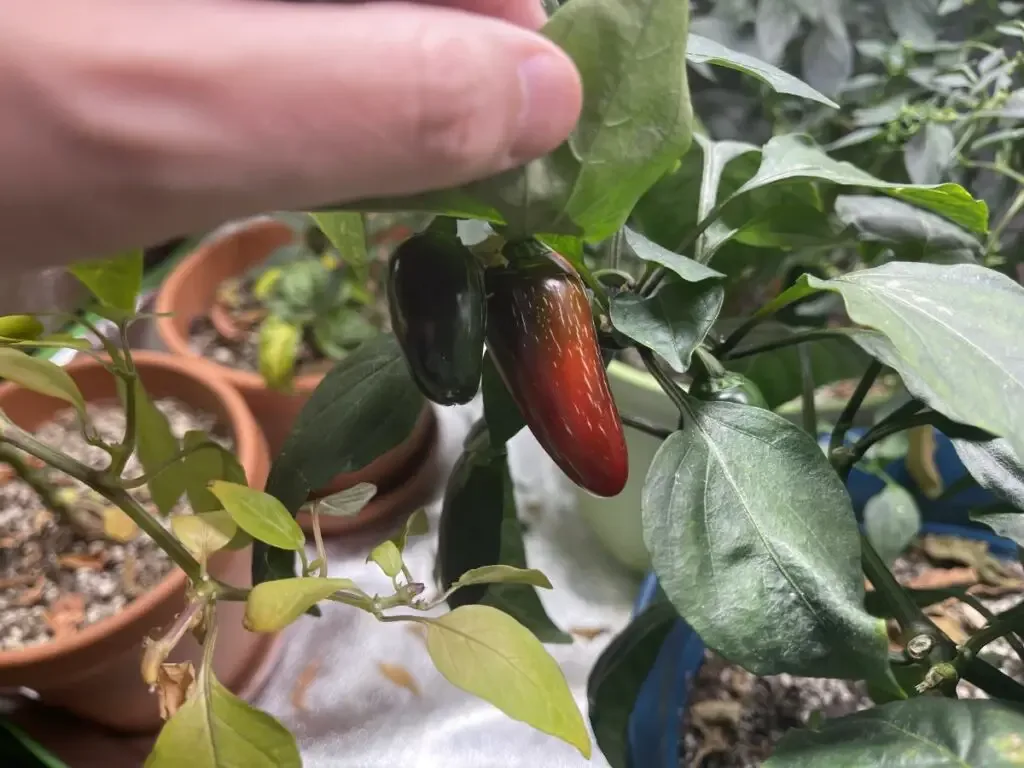Have you ever chomped into a homegrown Jalapeño pepper, braced yourself for the spicy kick, and looked forward to the endorphin rush that follows, only to be disappointed? Maybe your Jalapeño pepper had some zing but didn’t deliver the intense capsaicin content you hoped for.
Why would this happen? And how can you make your next batch of Jalapeños grow hotter?
We dug into this question and found that the internet is full of lore about what makes a Jalapeño hot or not. But based on our research and growing experience, we found three reliable factors.
The top three factors that determine how hot a Jalapeño pepper will be, are:
- Genetics. This includes both the Jalapeño variety and gene expression in an individual plant.
- Growing conditions and nutrient access.
- Age of the pepper post-pollination.
We’ll dig into each of these topics in detail.
But first, let’s establish some basics about what makes a Jalapeño pepper taste hot.

What Makes a Jalapeño Pepper Hot?
The chemicals that make a Jalapeño pepper taste hot are a group of compounds called capsaicinoids. The two main capsaicinoids found in chili peppers like Jalapeños are called capsaicin and dihydrocapsaicin. But there are at least 22 different capsaicinoids that can make a pepper hot.
When you eat a Jalapeño, these capsaicinoids bind to receptors on your tongue that literally communicate to your brain that your tongue is burning.
If you bite into a Jalapeño and it doesn’t seem hot, first make sure you’re tasting the right part of the pepper. The highest concentration of capsaicinoids is in the pith—the whitish area near the top of the pepper that holds the seeds in place.
So, if you only bite off the tip of a Jalapeño, it’s not going to give you the kick you expect. When you compare the hotness of two Jalapeños, make sure you’re eating the same part of each pepper.
How Hot Can a Jalapeño Pepper Get?
On the Scoville scale, the typical range for a Jalapeño pepper is between 2,000 and 10,000 Scoville Heat Units (SHU). So, while a Jalapeño can pack a kick, it’s never going to be a superhot pepper.
But 2,000 to 10,000 SHU is a pretty wide range. Depending on the amount of capsaicin in the fruit (as well as your personal tolerance), a Jalapeño could taste almost as benign as a Bell pepper or be biting hot.
So, let’s explore how to grow Jalapeños that earn a place on the hotter end of the spectrum.
Reason 1: The Right Genetics for a Hot Jalapeño Pepper
Genetics is the most powerful factor in determining whether a Jalapeño grows to be hot or not. There are many different Jalapeño varieties—that is, distinct genetic lines of Jalapeño plants—each with their typical capsaicinoid range.
Within a variety, gene expression in an individual plant will determine how spicy that plant’s fruit will become.
What Genes Make a Jalapeño Hot?
Scientists have identified a major gene responsible for the production of capsaicinoids in peppers and called it Pun1. The dominant allele is hot, and there are two recessive alleles (pun1, pun12) that produce a mild pepper.
In plain English, this means if the Jalapeño pepper has the dominant gene Pun1 in its DNA it will be a spicier pepper. However, if the Jalapeño pepper has two pieces of recessive genetic code in its DNA, pun1 and pun12, it will be mild. Below is a table illustrating this concept:
Table: Spice Levels by Genetic Breakdown
| Genotypes | Pun1 (Dominant) | Pun1 (Recessive) | Pun12 (Recessive) |
| Pun1 | Pun1, Pun1 Spiciest | Pun1, pun1 Moderately Spicy | Pun1, pun12 Moderately Spicy |
| pun1 | Pun1, pun1 Moderately Spicy | pun1, pun1 Not Spicy | pun1, pun12 Not Spicy |
| pun12 | Pun1, pun12 Moderately Spicy | pun1, pun12 Not Spicy | pun12, pun12 Not Spicy |
This table breaks down the spice levels of a pepper based on its dominant and recessive allele DNA structure.
You won’t have to worry about this too much. Almost all Jalapeño cultivars will have two copies of the Pun1 allele, so they will be spicy to some degree.
But Pun1 isn’t the only gene involved in producing a hot chili pepper. Scientists have identified 20 genes as candidates that can influence capsaicin production.
Does it sound complicated? Well, it is, and it isn’t. On one level it’s so complicated that researchers are just beginning to understand what makes a chili pepper pungent.
But on another level, backyard gardeners have been breeding hotter and hotter peppers for centuries without any knowledge of genetic sequencing. The action required is simple: All you have to do is save seeds from the hottest peppers you produce.

Will Jalapeños be Hotter if Cross-Pollinated by Other Varieties of Peppers?
Cross-pollination will not produce hotter peppers, at least not in the current generation. You can grow a Jalapeño plant right in between a Carolina Reaper and a Sweet pepper and none of the fruits that season will be affected. Your Jalapeños will still look and taste like Jalapeños, because of these two reasons:
1. Peppers are generally self-pollinating. Each flower includes both male and female parts, and usually pollinates itself.
2. If a Jalapeño flower is cross-pollinated with a different variety (whether manually or by insects), the fruit from that flower will still develop into a regular Jalapeño. But the seeds inside that fruit will be affected. The seeds will carry genetics from both parent plants.
If you plant those seeds, the resulting plants and fruits will be hybrids, combining traits from both parent plants.
How to Produce Seeds that Grow Hotter Jalapeños
If you plan to save your own seeds, taste a sample of peppers from every plant you grow and select seeds from the hottest-tasting peppers. If you repeat this process through multiple generations, your average Jalapeño will grow more and more spicy. It’s really that simple!
If you want to combine traits of two different Jalapeño pepper plants, you can manually cross-pollinate them.
This experiment might turn out just the way you hoped, or it might not! But beware: whether your cross-pollination effort worked the way you expected or not, you may find yourself nurturing a new hobby in plant breeding.
What Varieties of Jalapeños are the Hottest?
If you don’t plan to save your own seeds—or don’t want to wait for multiple generations of pepper breeding for hotter fruit—then you can buy heirloom or hybrid varieties of Jalapeño pepper seeds that have been developed to produce fruit with high capsaicin content.
These varieties may look and taste different from the Jalapeños you find in the supermarket. Fun fact: Commercial varieties of Jalapeños sold in the U.S. have had capsaicin bred out of them so they will be less spicy and better appeal to the masses.
Some of our favorite medium to hot Jalapeño varieties include:
- Purple Jalapeño: This is a medium-heat Jalapeño (around 5,000 SHU). Its fruit goes through a gorgeous purple stage before ripening to red.
- Jalafuego: These moderate-heat peppers have a range of 4,000 to 8,000 SHU.
- Biker Billy: Probably the hottest common Jalapeño hybrid, this pepper has a range of 5,000-10,000 SHU.

Reason 2: The Right Environment and Nutrients for a Spicy Jalapeño Pepper
Pepper plants are incredible living things, changing and adapting to the world around them. If you take seeds from the same pepper pod and plant them in different soils with different growing conditions, the flavor will be different in the resulting peppers from the two plants.It’s like when you cook a familiar recipe in your mother-in-law’s kitchen, and it turns out differently than when you cook it in your own.
By creating the ideal growing environment for hotter peppers, you can influence the capsaicin content of your Jalapeños.
Growing Conditions to Produce Hotter Jalapeños
Capsaicin production in hot peppers may be a response to stress. Home growers of Jalapeños often intentionally stress their plants by watering them infrequently to produce hotter peppers.
Research bears out this theory, but withholding water needs to be done at the right time. If you water-stress your Jalapeño too early in the plant’s lifecycle, you will reduce total fruit production.
When your Jalapeño plants are young and focusing on vegetative growth, let them have all the water and fertilizer they need to produce strong, full, and healthy stems and foliage. Let your plant burst into an abundance of blooms, and only once those blooms have set fruit, should you experiment with water reduction.
We prefer to start reducing water once the fruit is around 10-15 days old. As we’ll discuss below, Jalapeños reach their peak capsaicin content around 45 days after pollination. When we withhold water too early, we find that the overall fruit size turns out smaller.
How to Reduce Water to Produce Hotter Jalapeños
It’s always better to water your plants deeply and less frequently than to give them a little bit of water every day. Some growers wait until their Jalapeño plants begin to wilt before giving them more water, claiming that this produces hotter peppers.
One thing is for sure: inconsistent watering can lead to “corking” or stretch marks on your Jalapeño fruits. Some growers consider these vertical lines running down a Jalapeño to be a sign of increased heat in that pepper.
Crank Up the Temperature to Produce Hotter Jalapeños
Typically, hotter drier climates will produce hotter, more pungent peppers.
Growers have long made the claim that hotter nighttime temperatures are important when growing Jalapeños with higher capsaicin content.
Scientific studies have mixed results regarding environmental temperature’s effect on how hot a pepper becomes. (This study finds a correlation, while this more recent one does not.)
While we don’t have a perfect environmental temperature to recommend, we have to agree: hot peppers don’t like it soggy. Jalapeño plants growing in lush, cool conditions have no reason to ramp up the heat to survive.

Soil Nutrients to Produce Hotter Jalapeños
Unfortunately, there’s no magic supplement you can pour over the soil as your peppers are ripening to make them turn out hotter. But there are lots of things you can do to promote healthy growth.
Peppers like loamy, fertile, slightly acidic soil. Aim for a pH of 6 to 6.5.
Some growers say that adding sulfur to the soil will increase the hotness of your Jalapeño peppers. There’s no direct evidence of this but adding sulfur to the soil will increase its acidity. Depending on your original soil pH, this could lead to hotter peppers. But you should always test your soil pH before adding amendments.
Growers also sometimes say you should fertilize your Jalapeño plant less while it is fruiting, to stress the plant and increase capsaicin production. But we don’t recommend this practice.
Withholding fertilizer might increase the hotness of your Jalapeños, but it will come at the expense of your plant’s overall health. A plant that is stressed will be at risk for disease, stunted growth, and low overall yield. A stressed plant will produce stressed seeds—and if you’re going to save seeds, you definitely don’t want them stressed.
Furthermore, scientific studies haven’t borne out that fertilizing less will produce hotter peppers than providing adequate fertilizer. You shouldn’t need to play tricks on your Jalapeños to get them to produce hot peppers. You should grow plants that will reproduce prolifically in good environments and still produce hot peppers.
This study shows that adequate nitrogen is not only necessary for healthier plants, but that capsaicin content increased with optimal nitrogen levels. Plant health decreased when too much nitrogen was added.
A study on Habaneros produced similar results. These studies didn’t find a correlation between potassium levels and capsaicin production, but they did note that adequate potassium was key for overall production.
The takeaway is that intentionally stressing your plant by giving it way too much or too little of a particular nutrient is more likely to inhibit overall growth than to produce a hotter pepper.
For best results, grow your peppers where they are happy: in acidic, well-draining, compost-rich soil. Then reduce watering while the fruit is ripening and keep them warm at night.

Reason 3: Getting the Timing Right
If your Jalapeño is already flowering and setting fruit, it may be too late to influence the growing conditions too much, and it’s definitely too late to influence the genetics. But you can make sure you’re harvesting the hottest peppers your plant has the ability to produce by picking them at the right time.
Let Them Ripen on the Vine
Young Jalapeños—small fruits in their first month of growing after pollination— produce small but steadily increasing amounts of capsaicin. If you pick a baby Jalapeño, it’s going to taste more like a Bell pepper than a chili.
Peak concentrations of capsaicin are produced right around the time that the fruit starts to ripen, or change from green to red. For Jalapeños, that’s usually between 40 and 50 days after pollination.
But you don’t necessarily want to wait as long as possible to pick your Jalapeños. After 40-50 days, the capsaicinoids in a chili pepper begin to break down. If you see your red Jalapeños turn purplish at the tips, you’ve probably waited too long.
Timing it Right: The Jalapeño Spicy Spot
The exact timing of when a Jalapeño is at its hottest will vary from fruit to fruit, based on factors like temperature and sunlight that affect the rate of ripening. But you’ll be in the ballpark if you look for fruits that:
- have ripened to the point of turning red but are not blackish yet.
- have vertical lines or “corking” around the shoulders of the fruit.
- are roughly 45 days post-pollination.
Run Your Own Experiments For Timing on a Single Genetic Line
Test your own fruits regularly. If you grow the same variety of Jalapeños every year, or save seeds and develop your own line, you’ll come to recognize visual clues that your Jalapeños are at peak heat and are ready to pick.
You can experiment with different timing and growing conditions. As you observe and document your Jalapeño-growing journey, you’ll learn how they perform best in your unique environment.
